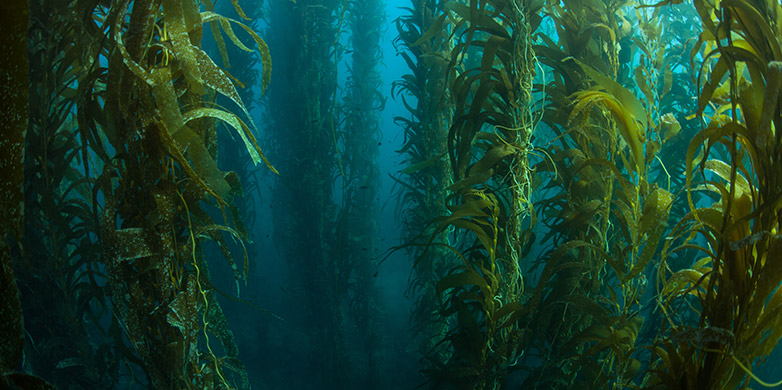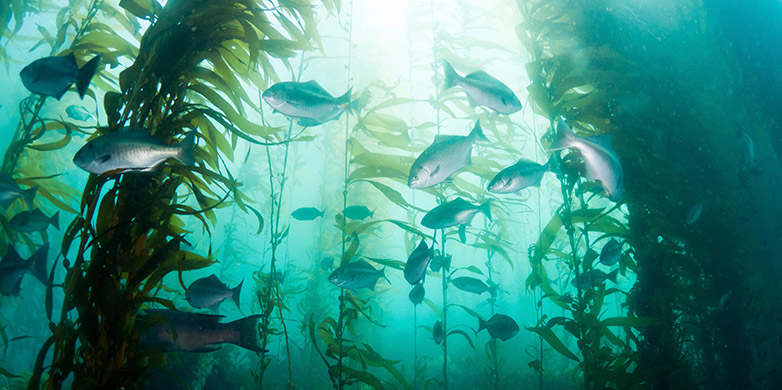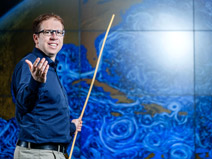Heatwaves in the ocean – a risk to ecosystems?
Marine ecosystems are responsible for about half of global annual primary production and more than one billion people rely on fish as their primary protein source. Latest studies show that enormous warm water bubbles in the ocean are having a noticeable impact on ecosystems. How should we interpret these changes?
Did you know that heatwaves not only occur on land, but also in the sea? We all remember the record-breaking European heatwave in summer of 2003: forests burned, rivers dried up and more than ten thousand people in Europe died as a result of the extremely high temperatures. [1] The marine environment – and in particular the organisms – also suffer from heat stress. Two exceptional heatwaves in the ocean during the past few years have alarmed us scientists. Humans will also feel their consequences in the long term.
Heatwaves in the Northeast Pacific...
An unusually long-lasting warm water bubble – nicknamed ‘The Blob’ – spread across the surface of the Northeast Pacific from winter 2013/2014 to the end of 2015. [2] The warm water bubble at times measured up to 1,600 kilometres in diameter and had water temperatures of more than 3 degrees Celsius above the long-term average. Because warm surface water has a lower density than the cold deep water, the exchange of nutrient-rich deep water with warm surface water was reduced, especially along the west coast of North America. This had far-reaching consequences for marine organisms and ecosystems: the growth of phytoplankton decreased due to the reduced supply of nutrients, and some zooplankton and fish species migrated from the warm and nutrient-poor water to cooler regions. By contrast, researchers found pygmy killer whales in the North Pacific for much longer than usual: this tropical whale species is usually observed 2,500 kilometres further south.
... and on the west coast of Australia

A stronger but shorter heatwave hit Australia‘s west coast at the turn of the year 2010/2011, with sea temperatures of up to 6 degrees Celsius above normal levels for that time of year. The seabed along the coast of Western Australia is known for its high concentration of brown algae. These marine ‘kelp forests’ have similar functions as terrestrial forests: they provide habitat and food resource to numerous species; in particular a large number of fish. Australian researchers demonstrated that most of the kelp forest stocks rapidly disappeared during this heatwave. [3] In total, an area of 1,000 square kilometres of kelp forest was lost – this corresponds to twice the size of Lake Constance. Today, algae stocks haven‘t recovered yet. Instead, a new ecosystem with tropical fish and seaweeds has developed.
Risks for marine ecosystems?
We have known for some time that extreme weather and climate events on land, such as heatwaves, shape the structure of biological systems and affect their biogeochemical functions and the services they provide for society in a fundamental manner. It is also known that heatwaves affect a number of biological systems, including humans, more strongly than slower changes in the average temperature. This has to do with the fact that such extreme events push organisms and ecosystems to their limits of their resilience and beyond, potentially causing dramatic and irreversible changes.
The two extreme events in the North Pacific and along the west coast of Australia detailed us for the first time that marine heatwaves can also lead to a number of unprecedented ecological and socioeconomic consequences. For example, it revealed that a large number of fish moved to colder northern waters. Escaping to cooler ocean depths is often not an option because deeper depths lack sunlight, oxygen and plants for food. This may ultimately lead to losses for both the fishing and tourism sectors.
Looking ahead
As the world‘s oceans continue to warm, marine heatwaves are likely to become more frequent and intense. Observations and model simulations also demonstrate that other factors such as ocean acidification and deoxygenation are putting additional stress on marine organisms and ecosystems (see also this post in the Klimablog).
Until recently, climate models were unable to accurately represent the relevant physical and biogeochemical processes to simulate extreme events in the ocean and predict future changes. The uncertainties in future projections, particularly at the regional scale, were simply too large. [4] New model simulations linking the global carbon and oxygen cycle with high-resolution physical processes now enable us to make quantitative predictions about the frequency, strength and spatial distribution of future extreme events in the ocean for the first time. And this is precisely what my scientific research focuses on. But in order to better understand the impact of these extreme events on individual organisms or entire ecosystems and their socioeconomic services, interdisciplinary collaborations are urgently needed. Research on understanding such events is only just beginning.
Further information
[1] According to this external page study, there were more than 70,000 additional deaths in Europe.
[2] Di Lorenzo, E., N. Mantua (2016): Multi-year persistence of the 2014/2015 North Pacific marine heatwave. Nature Climate Change, doi:10.1038/nclimate3082
[3] Wernberg, T., et al. (2016) Climate-driven regime shift of a temperate marine ecosystem. Science, 353, 169-172.
[4] Frölicher, T. L., et al. (2016) Sources of uncertainties in 21st century projections of potential ocean ecosystem stressors. Global Biogeochemical Cycles, 30, doi:10.1002/2015GB005338


Comments
Additional comments are available for the German version of this article. Show all comments
This is excellent and important work. Many lives and industries are vulnerable so please keep monitoring and reporting!
Great research! I think we should conduct continuous studies and research on Marine Biology, Climate Change, Marine Heatwaves, Ocean Acidification, Deoxygenation and of course overall Land, Sea, Air and Space Pollution Impact.